Film Name:紅海行動 / Operation Red Sea
Operation Red Sea was the film I most anticipated during this Spring Festival season, and it certainly lived up to my expectations: Without exaggeration, this marks a new milestone for domestic commercial blockbusters. Its production quality and final execution hold their own even when measured against Hollywood standards.
[Friendly reminder: The following text contains minor spoilers, but they should not significantly affect your enjoyment of the film.]
The primary reason for joining mainstream praise for “Operation Red Sea” lies in its authenticity and professionalism.
The film is adapted from the 2015 evacuation of Chinese nationals from Yemen. The “Jiaolong Special Forces” depicted in the film are a real-life Chinese naval special operations unit. The Type 054A guided-missile frigate featured is the actual Linyi-class vessel. Additionally, major military equipment such as T-72 tanks, M60 tanks, C-130 transport aircraft, and Cougar helicopters all make appearances.
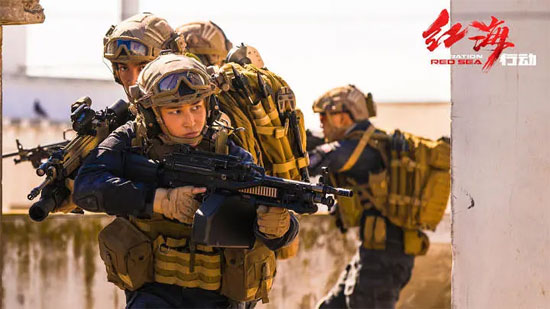
The firearms are no slouch either: Type 95 assault rifles, SCAR-Ls, R93 sniper rifles, CZ805A1 assault rifles, M249s, plus the ubiquitous M16s, AKs, and RPG rocket launchers, among others. opllx isn’t a military enthusiast—most of the above details were pointed out by knowledgeable viewers. My point is this: whether it’s flashy showmanship or genuine, hard-earned skill, audiences can sense the difference regardless of expertise. This level of “professional authenticity” can’t be faked.
Complementing the professional gear is the film’s (nearly) non-stop combat action: fighting pirates to rescue crew, taking on terrorists to save citizens, repelling ambushes in the wilderness, storming enemy bases for hostage rescue, and eliminating enemy leaders to intercept nuclear material. These five distinct battles—each unique yet interconnected—deliver thrilling spectacle while holding up to scrutiny from attentive viewers.
Take the highly memorable sniper battle, for instance—this kind of action-packed, substance-rich sequence is something domestic films have often lacked.
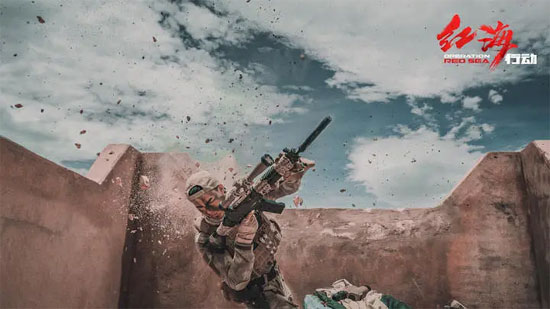
This “stillness” perfectly complements the “movement” of the frontal assaults, creating a balanced and indispensable dynamic.
Beyond Gu Shun and Li Dong, the enemy sniper is also rendered with grounded details. He’s portrayed as a young boy with a passion for nuts, who cleverly uses a tin box to reflect light and confuse opponents after discovering his position is compromised. When the base is ambushed, the one-eared sniper stubbornly vows to take out the enemy marksman… Though he has almost no lines, his limited screen time effectively captures the essence of a young warrior.
The film’s exhilarating action sequences owe much to director Dante Lam’s wholehearted dedication.
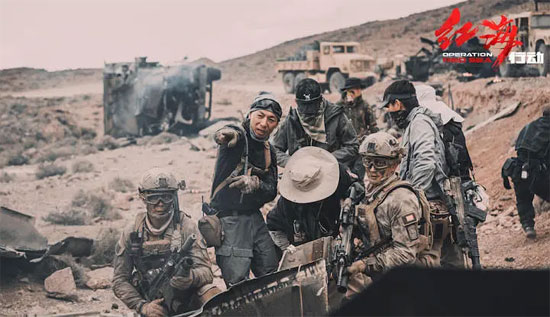
Though he was relatively unremarkable during Hong Kong cinema’s heyday, he swiftly found his niche while directing in mainland China. This wasn’t because he learned to “adapt,” but rather because he “didn’t change”—Lin Chaoxian is a knowledgeable military enthusiast with an insatiable passion for firearms. For him, transitioning from police thrillers to war films was simply playing on a bigger, more exhilarating scale.
After tasting the freedom of “Operation Mekong,” “Operation Red Sea” felt like a dream come true: entirely live-action, with full backing from the Chinese Navy and Moroccan government, and a $20 million budget spent almost entirely on equipment. He went all out pushing the actors (including himself)…
On set, Dante Lam communicates seamlessly with military consultants, designs action sequences, and personally directs actors on blocking and movement.
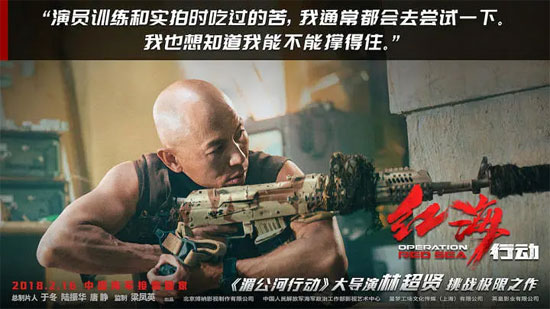
Professionalism is the film’s greatest strength, but that doesn’t mean it lacks merit in other areas.
As a film of the same genre, “Operation Red Sea” inevitably draws comparisons to last year’s box office phenomenon “Wolf Warriors 2.” And when you compare them…
“Wolf Warriors 2” follows the classic “superhero” blockbuster formula: a lone hero steps up to save the day, infiltrates enemy territory, and slaughters all in his path. Rebels and mercenaries are portrayed as mere straw men, easily defeated. While the hero saves the world, he also cracks jokes, wins the girl, and earns widespread acclaim. Operation Red Sea,” however, strives to recreate the realistic scale of warfare. There are no lone heroes, only collective operations. While the enemies are ruthless and brutal, they are no longer completely dim-witted. The protagonist team, while brave and tenacious, also suffers casualties and bloodshed.
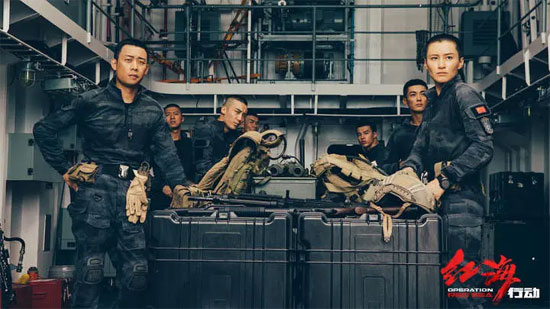
Neither film type is inherently superior, but the former relies on familiar commercial tropes. The latter—its ensemble portrayal and grounded realism—is rarer and better suited to our “national context.” After all, the image of soldiers cracking jokes amidst intense combat truly resonates more with American troops.
While the film’s weaknesses lie in its thin dramatic scenes and somewhat stereotypical characters, it’s commendable that it still manages to craft several memorable details within this context.
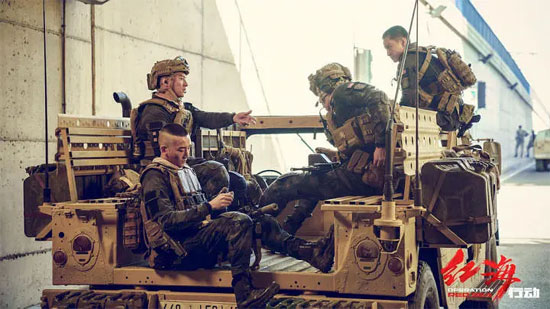
One such detail is “Stone” Zhang Tiande’s habit of eating candy during missions. Having grown up with his mother’s “a beating and a piece of candy” approach, he believes eating candy dulls the pain. Tong Li had several exchanges with him along the way. This interaction gave human depth to the moment when Tong Li feeds him candy as he sacrifices himself at the end, offering a rare glimpse of “small love” amidst the film’s overarching theme of “great righteousness.”
The other is the growth of observer Li Dong. Though he never voiced it, the accident where Luo Xing was shot during the pirate pursuit weighed heavily on his mind. This guilt and the self-doubt that followed became the primary “lesson” for the new sniper, Gu Shun, to teach him. Their interactions were sparse, yet they effectively conveyed the journey of forging a future sniper.
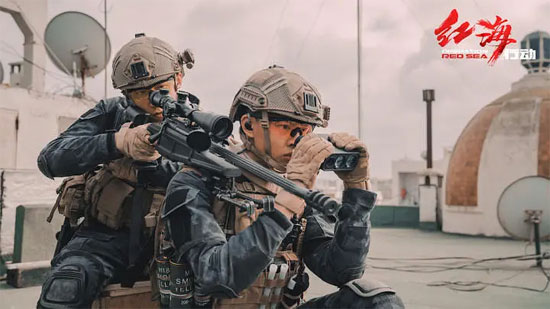
Additionally, both “severed finger” scenes effectively serve the main narrative: one depicts a local civilian’s ring finger being reattached by commandos, highlighting war’s brutality and the insignificance of individual strength; the other shows Zhuang Yu, during a close-quarters firefight, first spotting a severed finger on the ground before realizing it’s his own—reflecting war’s bloody, extreme violence.
Many viewers steer clear of such patriotic films largely because their nationalistic themes often come across as overly “red” or dogmatic. Take the scene in “Wolf Warriors 2” where the convoy passes through a war zone: Cold Blade and his team discard their weapons, relying solely on the waving national flag to ensure safe passage… The sentiment is overflowing, but it’s also too much. For many naturally reserved individuals, such intense and fierce visual impact can feel uncomfortable, lacking in “aesthetic appeal.”
In this regard, Operation Red Sea does an excellent job.
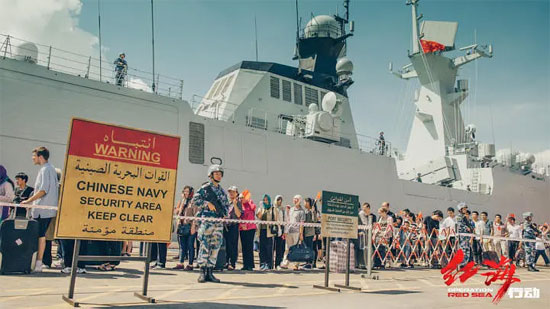
It certainly embraces patriotic themes, but without shouting them from the rooftops. Whether it’s the Jiaolong strike team rescuing hostages, the Linyi vessel sheltering expatriates, or the main crew undertaking missions beyond their orders, the film maintains a rational restraint—much like preserving composure on the battlefield. It’s concise and efficient, moving without being sentimental.
This approach of conveying its core message through action alone is far more convincing—because authenticity breeds belief, not the other way around.
Many have already drawn parallels to “Black Hawk Down.” That “Operation Red Sea” can be mentioned in the same breath as this classic war film is already a triumph for the latter. Of course, such comparisons primarily concern the scale of scenes and combat—the hardware value—while its ideological depth and weightiness likely fall short. This is also the most obvious flaw of “Operation Red Sea.”
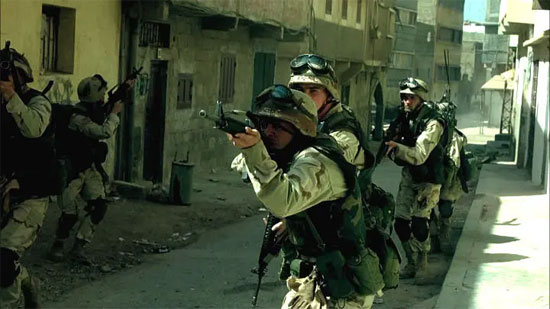
In “Black Hawk Down,” the American soldiers fight with unrestrained intensity. Yet throughout the battle, the suffocating question of “Is this war just? Does it hold meaning?” weighs heavily on every character. The pervasive sense of helplessness and despair, amplified by the explosive, brutal battlefield imagery, lends the film substantial depth and gritty authenticity.
In contrast, Operation Red Sea has everything except that soul-stirring complexity that elevates simplicity. Everything boils down to the simplest principles: no Chinese citizen can be lost, and if possible, we must rescue more innocents—and save the world while we’re at it. Some say “great war films are inherently anti-war.” Regardless of whether this view is correct, it certainly isn’t fully realized here.
The protagonists fall short, and the antagonists lack conviction. Why do the rebels and terrorists stir up global chaos? Why risk targeting Chinese citizens? Holding a child hostage to force the father into suicide bombing is indeed brutal and heartless—but where exactly do they derive their “popular support”?…
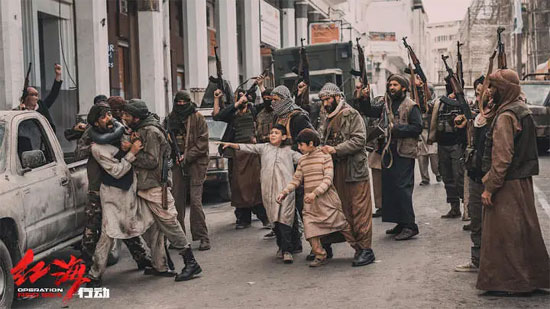
You can’t overthink these things, because if you start delving into more complex issues, the film’s tone would be completely distorted.
But this thinness and hollowness shouldn’t be used as an excuse to dismiss Operation Red Sea. We must acknowledge that in our environment, making a mainstream patriotic film—especially one with a military theme—inevitably faces limitations. Often, the question isn’t “whether it exists,” but “whether it can be done.”
I’ve never been one to dwell on ratings (since scoring systems are inherently subjective), but this time, the numbers do reveal something. Currently, “Operation Red Sea” holds an 8.5 rating on Douban, with nearly 110,000 reviews. While I believe Douban’s ratings tend toward strictness, it remains the most objective platform in the Chinese-speaking world. An 8.5 seems inflated for a film with such obvious weaknesses. Is it because audiences failed to recognize the film’s merits? Not necessarily.
Rather than focusing on its predictable shortcomings, most viewers are pleasantly surprised by the film’s unexpected progress, as it pushes Chinese cinema to new heights in this genre.
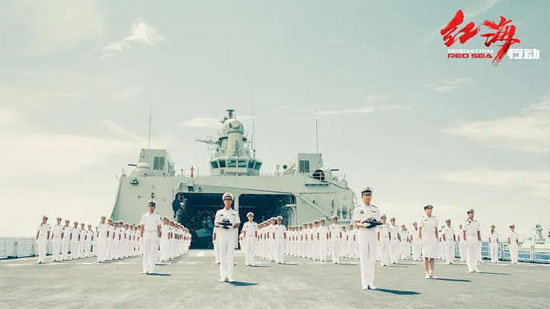
So, if you ask me about my stance on “Operation Red Sea,” I’ll naturally “go with the flow” and give it my unreserved praise.
To draw an imperfect analogy: for certain reasons, our examinees can’t reach the final 20 points on a 100-point exam. So for us, perfection might be 80 points. Rather than sourly lamenting those elusive 20 points with sighs of “unattainable, impossible to achieve,” it’s better to praise the examinee who strived for and earned that 80… In an environment where most fail to meet expectations, last year’s “Wolf Warriors 2” received unprecedented acclaim for scoring a 70. “Operation Red Sea” deserves even greater praise (the scoring is merely an analogy—don’t take it too literally).
As the saying goes, the film achieves “belief through authenticity, not authenticity through belief.”
Please specify:Anime Phone Cases » Operation Red Sea 紅海行動 2018 Film Review: It is only because something is true that we believe it, not because we believe it that it becomes true.